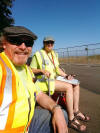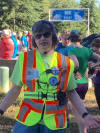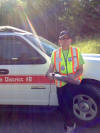|
North Olympic Discovery Marathon
June 7, 2015
ARES Ham Radio Involvement
This page provides information about Clallam County ARES participation in in providing communications support for the NODM event.
Visit the North Olympic Discovery Marathon (NODM) website to read about the details on the race.
This event covers the Olympic Discovery trail, the Old Olympic Highway, and local streets. Because of this, ARES volunteers provide emergency communications for safety. ARES volunteers are stationed along the route, mostly at one of the water stations (which may or may not coincide with an Aid Station.)
On the day of the event, the ARES participants check in with the marathon "Finish" operator once they arrive at their assigned station.
Summary of Radio Needs:
- Provide one or two radio operators at each staffed position
- Communicate information from your assigned position to Finish to relay to race officials
- The function
of "Finish" operators will be to communicate:
- Any medical or other emergency to staff and medical team
- Inform other ham radio team members of any developments that would be of interest
- Communicate with the Fire District personnel in the Incident Command Vehicle
Radio Frequencies in use on race day
| Function | Frequency | PL Tone | Comments |
| Primary Communications | 146.760 | 100.0 | Channel 17 - Stripped Peak repeater |
| Backup frequency | 145.290 | 167.9 | Channel 6 - Mt. Douglas BC |
Supporting information, FAQ
The vast majority of medical problems are muscle cramps and related ailments. Often they may resemble a "charlie horse" type pain and some may have never experienced one before. Not a pleasant feeling! The person may or may not be able to move on his or her own. The usual guidence is to direct them to the nearest AID station where some comfort can be provided. Massage usually eases the pain but thats not your job. Notify "finish" of their "bib" number and nature of compliant. If possible, have them stay with you until you get further instructions so staff can verify what is the best plan. They usually recover enough to gain mobility on their own. These are usually not serious and require no further assistance. At least one ham station can expect to be approached by someone with this medical condition. Know where to direct them and how to handle it. You will look much more professional if you think these out beforehand.
Spot danger, save a life - Signs of heatstroke vary — but they may include:
Skin that is red, hot and dry — but not sweaty
Rapid pulse
Dizziness
Labored breathing
Confusion, hallucination or seizures
Unconsciousness
It's an emergency! If you think someone has heatstroke, call 911. While you wait for help to arrive, move the person to the shade. Take off any of his or her unneeded or tight clothing. And if possible, place cold compresses — or cool, wet towels or sheets — against the skin. Start with these hot spots: the head, neck, groin and armpits. Or fan — while lightly spraying or sponging the person with water.
If a serious condition is suggested, call 911 for immediate help or call on the radio. A medical team will be ready to help. Be sure and give "bib" number, nature of problem and your location. Medical problems of this nature have highest priority. Also, notify any others in your vicinity that might have medical training. Stay close to the radio/racer and offer help and comfort but only to the limits of your medical training. Keep "Finish" informed of status until professional help arrives. The sports doctor tells us that a race of this nature will average one serious medical condition in about four races. Statistically, maybe one in 5,000 racers.
What if a runner wants to leave the course?
If you are approached by someone with this request, they should be directed to the nearest water station which may be co-located with our radio assignments. Follow reporting directions above as for minor medical conditions. A course marshal will make any decisions regarding the runner. Too often a runner says they are going to drop out but then decides to return when he/she feels better. Ask them to notify you if they change their mind because people could be looking for them. We need you to radio Finish with the bib number and gender of anyone dropping out of the race.
What else do we do?
Relay racer status information to Finish: 1st male, 1st female, for both full and half-marathon. Full marathon runners have yellow bib backgrounds, half's have green backgrounds. Encourage runners: cheer & clap, or whatever moves you. Present a professional demeanor of the organization, wear your ARES vest, be friendly to the event staff. Have fun!
What do we use for call signs?
Use tactical call signs for frequent communications but be sure to ID periodically per FCC requirements.
2015 Position Assignments
| Tactical Name | Position | Name / Callsign | Start Time | Comments |
| Start | #1 | Lee KE7TTY | 0700 | Agnew Soccer fields Relocates to WS 7/8 |
| #2 | ||||
| WS 6 | #1 | Bill W6JEQ | 0800 | |
| #2 | ||||
| WS 7/8 | #1 | Lee KE7TTY | 0845 | Matson & Finn Hall or |
| #2 | Monterra & Finn Hall | |||
| WS 9 | #1 | Steve N1SB | 0815 | External antenna required |
| #2 | Larry KE7KWA | Seibert Creek & Old Olympic Hwy | ||
| Bagley Crk Rd | #1 | Janet WA7JEP | 0815 | Bagley Creek Rd. & ODT |
| #2 | ||||
| WS 11 | #1 | Kathleen N1ERT | 0730 | Buchanan Dr. & ODT |
| #2 | ||||
| Morse Crk | #1 | Bruce KD7WBM | 0730 | External antenna required |
| #2 | ||||
| WS 13 | #1 | Valerie KF7VAL | 0830 | Rayonier & Ennis Bridge |
| #2 | Sheldon N7XEI | |||
| Finish | #1 | Rik WX7RIK | 0700 | External antenna required |
| #2 | David KE7TTT |
| Click on the thumbnails to see photos | |||||
 WX7RIK & KE7TTT Finish |
 KF7VAL & N7XEI Water Station 13 |
 N1ERT Water Station 11 |
N1SB & KE7KWA Water Station 9 |
W6JEQ Water Station 6 |
 KD7WBM Morse Creek |
Thanks to all the volunteers who worked this event!
Page Updated: 12/11/24
|
|
|
|
|
|
|
|
|
|
|
|
|
|
|
|
|
|
|
|
|
|
|
How do I sign onto VIMS? |
|
|
|
|
|
|
| Expanded Calendar |
Local Area Repeater | ||
Central & East Ends | ||
Frequency |
Tone |
|
145.130- |
100.0 |
WF7W |
145.150- |
114.8 |
N7UTB |
146.760- |
100.0 |
W7FEL |
146.760- |
77.0 |
W7FEL |
146.840- |
100.0 |
VE7VIC |
145.190- |
127.3 |
N7HNM |
442.100+ |
100.0 |
KC7EQO |
443.950+ |
100.0 |
VE7RTC |
444.875+ |
107.2 |
VE7USA |
West End | ||
145.210- |
100 |
W7FEL |
|
|
|
|

